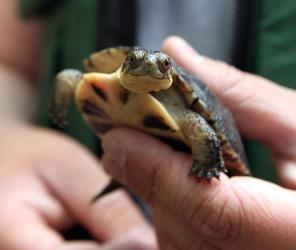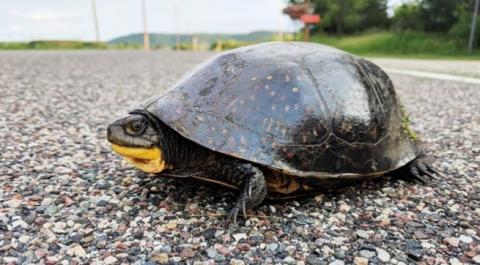USDA-APHIS Wildlife Services are collaborating with natural resources managers to address predation on Blanding’s and spotted turtles, both endangered Great Lakes reptiles requiring special conservation attention. Blanding’s turtle and spotted turtle are semi-aquatic turtles found in different parts of the Great Lakes region. Recovery efforts for both species face similar challenges. The areas where they reside are experiencing landscape modifications and development that is directly and indirectly resulting in their population decline. U.S. Fish and Wildlife Service will consider both species for listing under the federal Endangered Species Act in 2023.
Wildlife Services scientists and the Lake County Forest Preserve District conducted research and initiated population protection efforts on Blanding’s turtles within the forest preserves of Lake County, Illinois. Their efforts included tracking radio-marked turtles and monitoring nesting success. Additionally, some turtles were hatched in captivity and released when they were large enough to be less vulnerable to predation.
In Ohio, regional park districts and natural resource/wildlife management organizations formed the “Save and Protect Ohio’s Turtle Diversity” advisory committee to address conservation challenges of freshwater turtles in Ohio. The initial focus of the committee was the spotted turtle. Spotted turtle populations were declining due to nest depredation and the absence of juvenile turtles in the population. The committee educates the public on turtle conservation and aims to increase spotted turtle populations and hatchling survivorship through habitat management to improve nesting sites and a captive hatching and releasing program.
These conservation efforts were funded in part by the GLRI from USDA-APHIS Wildlife Service. Wildlife Services and cooperating agencies continue to collaborate to effectively sustain the viability of threatened turtle populations.
This post is based on a longer article titled “Spotting the Problem for Great Lakes Turtles- Wildlife Services and Partners Reduce Predation on Vulnerable Reptiles” published in the May/June issue of The Wildlife Society.



